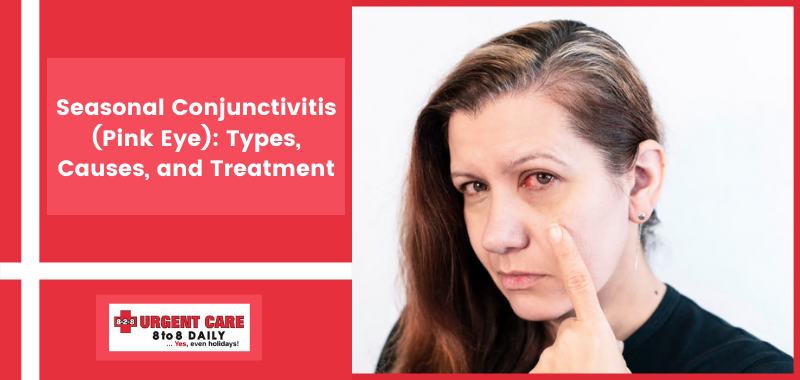


Seasonal conjunctivitis, or pink eye, is a condition that impacts millions of people each year. In the United States alone, approximately 6 million people are affected by conjunctivitis each year. Often linked to allergies, seasonal conjunctivitis can cause discomfort, irritation, and disruptions to daily life. Recognizing symptoms and exploring treatment options is essential for effective management, particularly during allergy seasons when triggers like pollen and grass are most prevalent.
Conjunctivitis refers to inflammation of the conjunctiva, the thin membrane that lines the white part of the eye and the inside of the eyelids. It’s commonly referred to as “pink eye” due to the redness caused by irritated blood vessels.
Seasonal conjunctivitis differs from infectious conjunctivitis in that it is primarily triggered by allergens rather than viruses or bacteria. This makes it particularly common during spring and summer when environmental allergens are abundant.
There are several types of conjunctivitis, each with distinct causes and symptoms:
The primary culprits of seasonal conjunctivitis are allergens, which can be found both outdoors and indoors:
When allergens come into contact with the eyes, the immune system releases histamines, causing inflammation, redness, and swelling hallmarks of seasonal conjunctivitis.
Seasonal conjunctivitis can be identified by several hallmark symptoms:
Symptoms often intensify during high-pollen periods or with prolonged exposure to allergens.
While avoiding allergens entirely may not be feasible, these strategies can help reduce exposure and risk:
Taking these preventive measures can significantly lower the chances of developing seasonal pink eye.
For most cases, seasonal conjunctivitis can be managed effectively at home. Here’s how:
While most cases improve with at-home care, you should see a healthcare provider if:
Prompt medical intervention can prevent complications and ensure appropriate treatment.
Seasonal conjunctivitis may be common, but with the right care and precautions, it doesn’t have to disrupt your life. Recognizing the symptoms early, understanding the triggers, and adopting preventive measures can go a long way in managing this condition. If symptoms persist or become severe, reaching out to a healthcare professional is vital to ensure proper treatment and avoid complications.
Proactively caring for your eyes during allergy season not only alleviates discomfort but also helps you maintain better overall eye health.
If you’re experiencing persistent or severe symptoms of seasonal conjunctivitis, don’t wait to seek help. At 8-2-8 Urgent Care, our dedicated team provides expert guidance and personalized treatment recommendations.
Reach out today to start your journey toward relief. Contact us at 760-216-6253, and our staff will walk you through our self-check-in process from the comfort of your home.